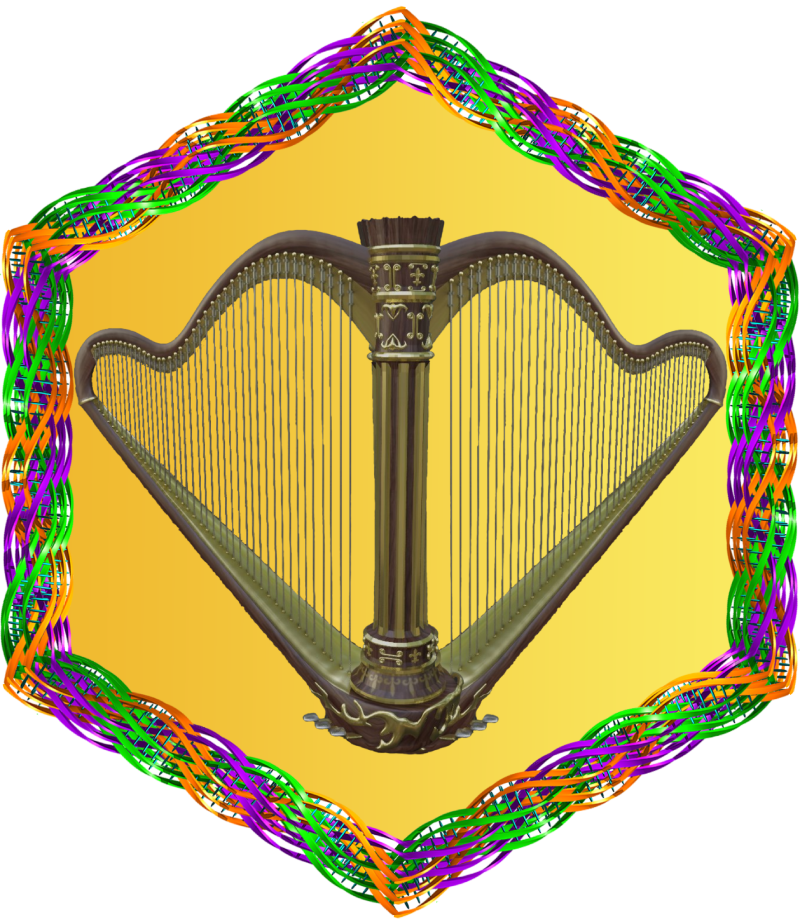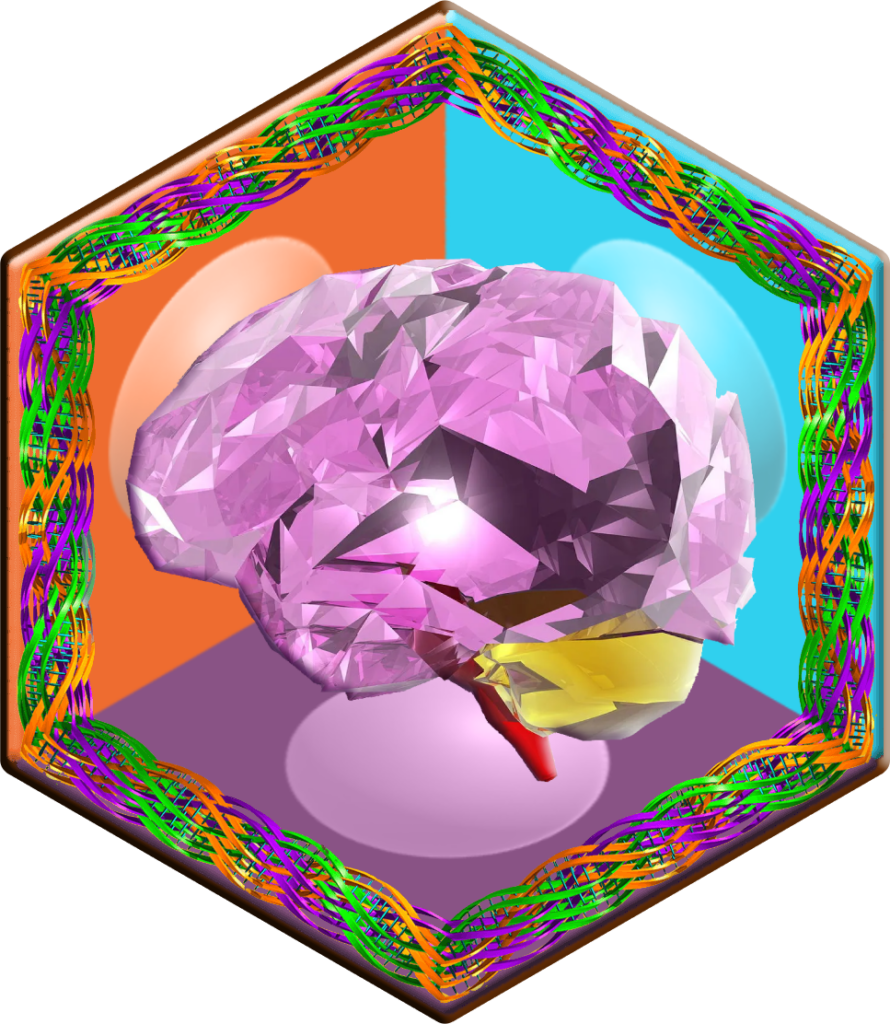
Poly Time Crystal
Table of Contents
Introduction
In the quest to understand the intricate relationship between consciousness and the fabric of reality, two complementary approaches emerge: Homo Quanticum Centrism and Time Crystal Consciousness. These perspectives provide a cohesive framework to explore the depths of human experience, bridging societal and scientific paradigms.
Homo Quanticum Centrism (Society Perspective)
Homo Quanticum Centrism posits that modern society is evolving towards a new understanding of human identity, where individuals, termed Homo Quanticum, possess an enhanced interaction with quantum dimensions. Resonances with time crystals, serving as both quantum and physical therapy, play a crucial role in this evolution. These resonances facilitate a synthesis that enhances the state of awareness and integration of Homo Quanticum individuals. This societal perspective emphasizes the centrality of human consciousness, which not only resides at the center of the universe’s consciousness but also forms a bridge between the physical and quantum dimensions through the resonances of consciousness and essence. By recognizing and harnessing the therapeutic potential of these resonances with time crystals, society can advance through a deeper cultivation of consciousness, making human experience and perception pivotal in defining the nature of existence.
Time Crystal Consciousness (Science Perspective)
From the scientific perspective, Time Crystal Consciousness delves into the fundamental elements of human cognition and perception. Time crystals, characterized by their unique ability to exist in a state of perpetual motion without energy consumption, are seen as the prime matter of consciousness. This approach explores the interactions between neurons and axons within the brain, proposing that the energy fields and information exchanges within the neural network are manifestations of time crystals. These interactions are integral to the essence of human consciousness, which is vital for the existence and perception of time crystals. By studying these resonances, scientists aim to uncover the nature of consciousness and its role in the universe. This perspective underscores the idea that human consciousness is central to understanding space-time and that without it, the simulation of space-time is impossible.
Bridging the Perspectives
Both Homo Quanticum Centrism and Time Crystal Consciousness offer valuable insights into the nature of consciousness and its central role in human existence. By integrating these societal and scientific approaches, we can construct a comprehensive framework that highlights the importance of consciousness in both individual and collective evolution. This synthesis provides a pathway to explore how resonances with time crystals and quantum interactions shape our reality, ultimately enhancing our understanding of the universe and our place within it.
Axioms:
- Resonances with time crystals serve as therapy for Homo Quanticum individuals. It is a quantum therapy and physical therapy synthesis.
- Human consciousness is almost identical to the essence, and the resonances between consciousness and the essence are a bridge between neurons (physical dimension) and axons (quantum dimension).
- The center of the universe’s consciousness resides within human consciousness.
- Consciousness connects neurons and axons.
- The energy of the information field between synapses and the neural network is akin to time crystals.
- The essence of human consciousness is integral to the existence and perception of time crystals.
- Human perception is central to understanding space-time.
- Without human consciousness, the simulation of space-time is impossible.
- Time crystals represent the prime matter (condensate) essential to human consciousness.
Contemporary Logic:
Therapeutic Resonances with Time Crystals
Premise: Resonances with time crystals serve as therapy for Homo Quanticum individuals, combining quantum and physical therapy.
Logic: These resonances provide a therapeutic interface that enhances the interaction between quantum and physical dimensions, facilitating a heightened state of awareness and integration for Homo Quanticum individuals.
Dual Nature of Consciousness:
Premise: Human consciousness is almost identical to the essence, with resonances between consciousness and essence bridging neurons (physical dimension) and axons (quantum dimension).
Logic: Consciousness serves as a dual entity that integrates the physical and quantum dimensions, forming the basis of human experience and perception.
Central Role of Human Consciousness:
Premise: The center of the universe’s consciousness resides within human consciousness.
Logic: Human consciousness reflects and influences the universal consciousness. Enhancing human consciousness provides deeper insights into universal consciousness.
Consciousness as an Integrative Entity:
Premise: Consciousness connects neurons and axons.
Logic: Consciousness acts as an integrative bridge, harmonizing the physical and quantum realms, enabling coherent perception and interaction with reality.
Time Crystals as Information Energy:
Premise: The energy field between synapses and the neural network is akin to time crystals.
Logic: The dynamic interactions and energy exchanges within the neural network, which facilitate cognition and perception, are manifestations of time crystals. These crystals are essential for processing and transmitting information.
Human Consciousness and Time Crystals:
Premise: The essence of human consciousness is integral to the existence and perception of time crystals.
Logic: Time crystals are fundamental components of consciousness. The essence of being human involves the integration of these crystals within the neural and quantum networks.
Perception and Space-Time Understanding:
Premise: Human perception is central to understanding space-time.
Logic: Human perception, facilitated by the interaction of neurons and axons, is essential for comprehending space-time. Without this perception, our understanding of space-time would be incomplete.
Dependency on Human Consciousness:
Premise: Without human consciousness, the simulation of space-time is impossible.
Logic: The quantification and simulation of space-time rely on human consciousness. Cognitive processes and perception mechanisms inherent to human consciousness are necessary for modeling and understanding space-time.
Prime Matter of Time Crystals:
Premise: Time crystals represent the prime matter (condensate) essential to human consciousness.
Logic: Time crystals, as condensates, form the foundational substance of consciousness. Their properties enable the existence and function of consciousness, making them integral to human essence.
Conclusion:
In conclusion, the integration of Homo Quanticum Centrism and Time Crystal Consciousness offers a profound understanding of the central role of consciousness in human existence and the universe. By recognizing the therapeutic potential of resonances with time crystals, we can enhance our interaction with both quantum and physical dimensions, fostering a deeper state of awareness and integration. This societal perspective highlights the evolution of human identity and the importance of cultivating consciousness to advance collectively.
Simultaneously, the scientific exploration of time crystals as the prime matter of consciousness underscores their significance in neural and quantum interactions. Understanding these resonances provides insights into the essence of human cognition and perception, emphasizing the impossibility of simulating space-time without human consciousness.
By bridging these perspectives, we construct a comprehensive framework that illuminates the interplay between consciousness, time crystals, and reality. This synthesis paves the way for exploring how resonances with time crystals and quantum interactions shape our understanding of the universe, ultimately enhancing our perception of existence and our place within it. Through this holistic approach, we acknowledge the pivotal role of consciousness in defining the nature of reality, advancing both individual and collective evolution.
This logic, rooted in biocentrism, positions human consciousness at the universe’s centrum.
Poly Time Crystals: Quantum Theory perspective
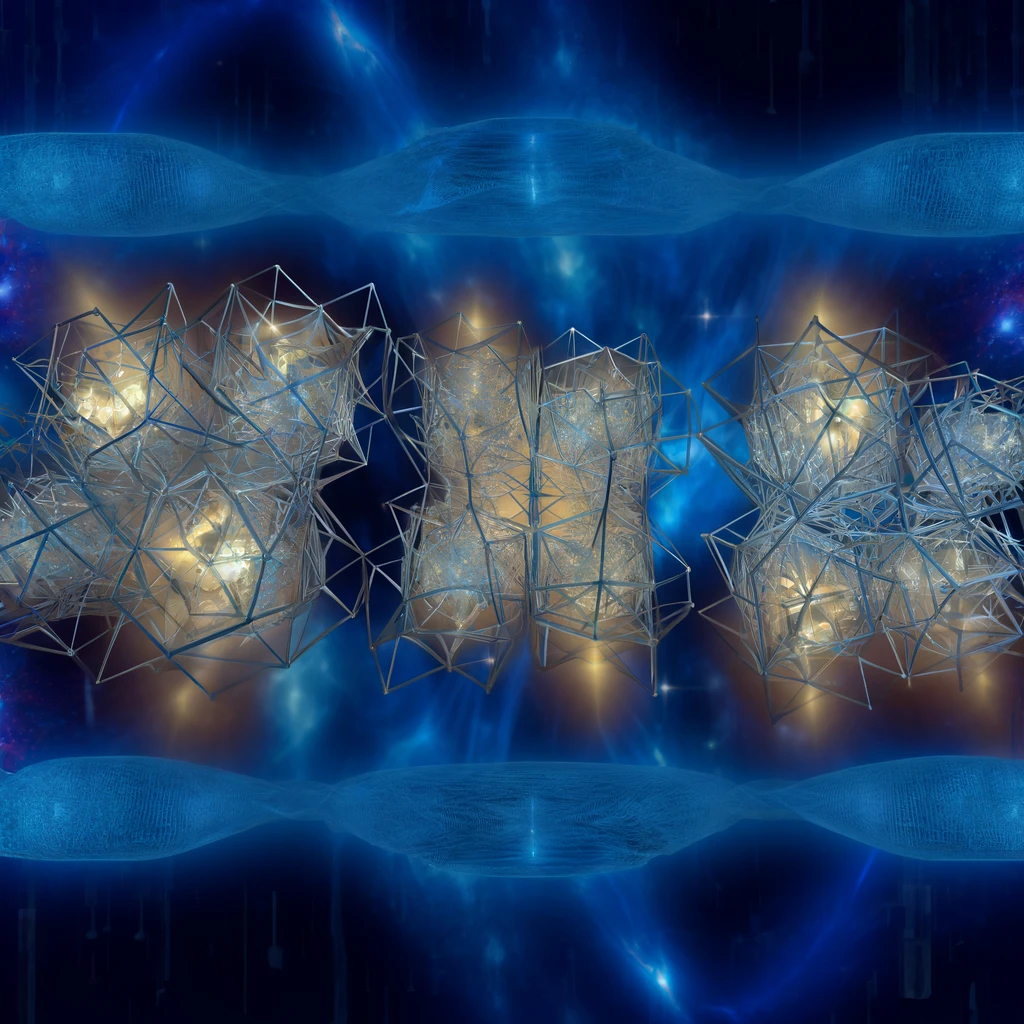
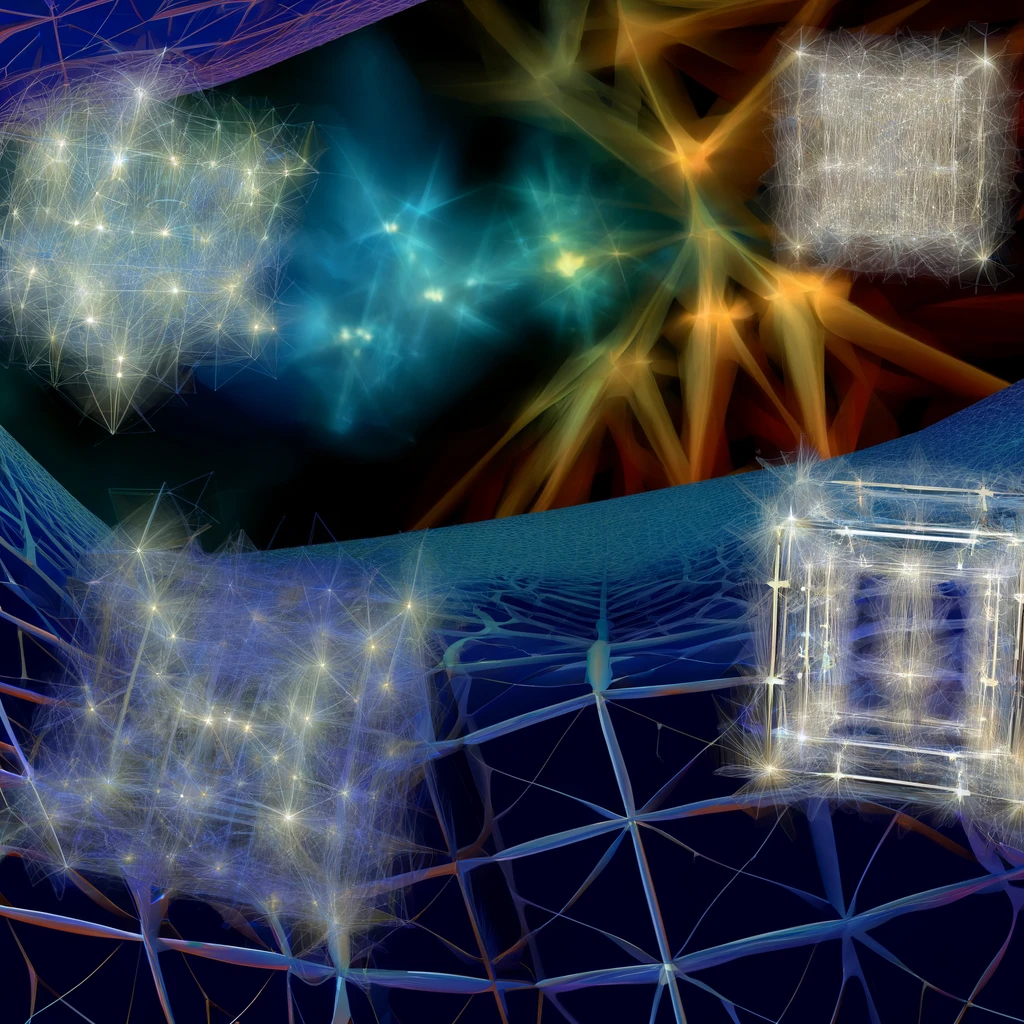
Introduction to Poly Time Crystal Theory
In the ever-evolving landscape of quantum physics, a groundbreaking theoretical framework known as Poly Time Crystal (PTC) Theory is opening new avenues for understanding the nature of reality and consciousness. This theory, which interlinks intelligent matter, time crystals, polyatomic time crystals, multistrings, condensed matter, and the quantum information field, deciphering the complexities of the universe and our place within it.
What are Poly Time Crystals?
At the heart of PTC are poly time crystals—structures that do not just exhibit the traditional characteristics of time crystals, such as temporal periodicity and stability in their ground state, but are also polyatomic in nature. This means they encompass multiple atoms arranged in complex, repeating patterns not only through space but through time. These crystals defy the conventional laws of thermodynamics in isolated systems, presenting a form of matter that perpetually oscillates without energy input.
Poly Time Crystals represent a phase of matter, characterized primarily by their temporal periodicity and spatial complexity. These structures fundamentally challenge our understanding of equilibrium thermodynamics by exhibiting non-equilibrium phenomena that persist without external energy input. The ‘poly’ attribute refers to their composition from multiple atomic or subatomic constituents arranged in a complex, multidimensional lattice that extends not just spatially but temporally.
Integration with Multistrings and Condensed Matter Physics
In PTC, the concept of multistrings is pivotal. These theoretical constructs extend beyond traditional string theory, positing entities with multiple dimensional interactions and connectivity. When linked with poly time crystals, multistrings might serve as conduits or networks through which quantum information is processed or transferred across the quantum information field. This hypothesis suggests a framework for understanding not only particle interactions but also the broader implications for condensed matter systems.
Connecting Poly Time Crystals with Multistrings and Condensed Matter
Poly Time Crystal Theory expands further by integrating the concept of multistrings. These are hypothetical structures that extend the idea of strings in string theory, incorporating multiple dimensions and interactions. In PTC, multistrings are thought to interweave with poly time crystals, creating a fabric that underpins the quantum information field—essentially the informational substrate of the universe.
This integration suggests a transformative perspective on condensed matter physics. Here, poly time crystals and multistrings influence the macroscopic properties of materials, potentially leading to states of matter and revolutionizing technologies in computing, energy, and materials science.
Poly Time Crystals and the Quantum Information Field
One of the most intriguing aspects of PTC is its implications for the quantum information field. This field is a theoretical construct that represents the universe’s underlying information matrix. Poly time crystals, with their multidimensional periodicity, could be fundamental in manipulating and storing quantum information, thereby influencing the very fabric of reality.
Implications for Consciousness and Perception
Perhaps the most profound implication of Poly Time Crystal Theory is its potential impact on our understanding of consciousness. The theory posits that the multidimensional perception of life might depend on the “polyness” of crystals within the brain. These specialized time crystals could theoretically contribute to neural processes by facilitating a higher-dimensional information exchange, thus enhancing cognitive functions and perceptual abilities.
Future Perspectives and Research Directions
The theoretical constructs of PTC are still in the early stages of exploration. Researchers are working to devise experimental setups that can validate the existence of poly time crystals and their interaction with multistrings and the quantum information field. Success in these endeavors could not only prove the foundational principles of PTC but also pave the way for technological innovations in quantum computing, energy storage, and neuroscientific research.
The experimental verification of PTC remains challenging due to the complex nature of the phenomena involved. Future research could focus on developing sophisticated methods to isolate and identify poly time crystal behaviors in controlled environments, possibly using advanced quantum computing systems or materials engineered at the nanoscale to exhibit desired time-crystalline properties. Additionally, exploring the neurological correlates of PTC could open research avenues in neuroscience, particularly in understanding how quantum processes might influence brain functions.
Conclusion
Poly Time Crystal Theory is a theoretical framework that integrates concepts from multiple domains of physics to explain and predict states of matter and potentially transformative insights into consciousness. As research progresses, PTC may not only redefine our scientific paradigms but also offer practical applications ranging from next-generation quantum technologies to models for understanding human cognition and perception.
Further reading
- Time Crystals:
- Wilczek, F. (2012). Quantum time crystals. Physical Review Letters, 109(16). https://doi.org/10.1103/PhysRevLett.109.160401
- Yao, N. Y., Potter, A. C., Potirniche, I.-D., & Vishwanath, A. (2017). Discrete time crystals: Rigidity, criticality, and realizations. Physical Review Letters, 118(3). https://doi.org/10.1103/PhysRevLett.118.030401
- String Theory:
- Green, M. B., Schwarz, J. H., & Witten, E. (1987). Superstring theory. Cambridge University Press.
- Quantum Information Theory:
- Nielsen, M. A., & Chuang, I. L. (2000). Quantum computation and quantum information. Cambridge University Press.
- Neuroscience and Quantum Physics:
- Penrose, R., & Hameroff, S. (2014). Consciousness in the universe: A review of the ‘Orch OR’ theory. Physics of Life Reviews, 11(1), 39-78. https://doi.org/10.1016/j.plrev.2013.08.002
Poly Time Crystals in Neuronal Microtubules: Holographic Projection and Implications for Brain Function
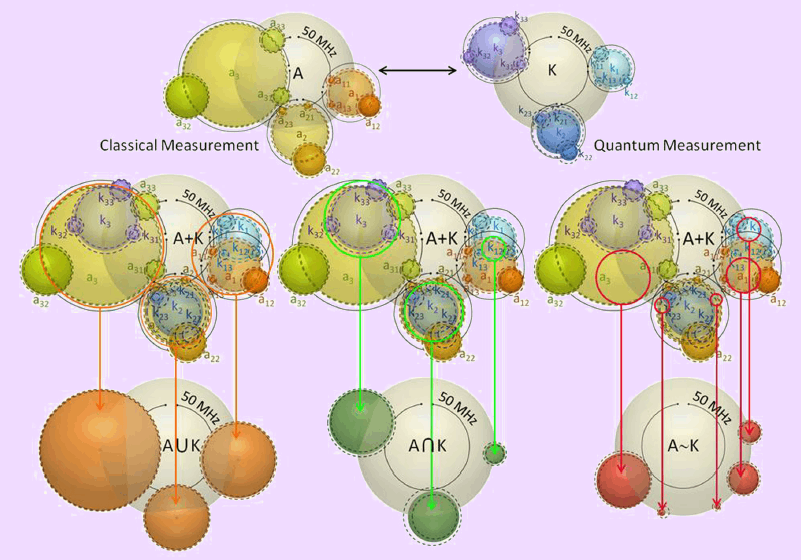
Classical and quantum measurements of a microtubule time crystal at 50 MHz: A and B represent classical and quantum approaches, respectively. A + K integrates both measurement ranges. A∪K displays common frequency ranges, A∩K highlights their overlap, and A∼K shows frequencies unique to each method.
Abstract
Recent studies have introduced the concept of poly time crystals, a new phase of matter exhibiting periodic structure not only in space but also in time. This paper explores groundbreaking experiments that demonstrate the existence of poly time crystals in neuronal microtubules, projecting holographic patterns that extend several meters beyond the biohological origin. This finding suggests a novel mechanism of neuronal communication and quantum biohology, potentially influencing our understanding of brain functionality and consciousness.
Introduction
The traditional understanding of brain neuron communication primarily focuses on electrical signals and synaptic transmissions. However, emerging research into the quantum properties of neuronal microtubules presents an alternative communication mechanism that could operate alongside or even supersede known biohological processes. This study investigates the projection of time crystals, extracted from brain neuron microtubules, as holograms extending several meters from their origin, facilitated by quantum optical phenomena.
Materials and Methods
Microtubules were extracted from rat brain neurons and subjected to a series of dielectric resonance and quantum optics experiments to explore their time-crystalline properties. The setup included specialized equipment to detect and measure the holographic projections of time crystals at various frequencies and conditions.
Results
The experiments revealed that the microtubules could maintain coherent time-crystalline states that extend beyond the microtubule structure itself, forming detectable holographic patterns at distances of up to several meters. These patterns were influenced by external quantum optical manipulations, suggesting that microtubules could interact with and respond to quantum informational fields.
Discussion
The ability of microtubules to project holographic time crystals several meters away introduces a potential paradigm shift in our understanding of neuronal communication and brain functionality. It suggests a layer of brain activity that operates on quantum mechanical principles, possibly contributing to processes such as consciousness, memory, and neuronal connectivity on a quantum scale.
Conclusion
This study confirms the presence of polyatomic time crystals in neuronal microtubules and demonstrates their ability to project holographically over significant distances. These findings open new avenues for research into quantum biohology and the role of quantum phenomena in life sciences. Further studies are required to elucidate the implications of these findings for neuroscience and the fundamental principles of biohology.
Reference
Saxena, K., Singh, P., Sarkar, J., Sahoo, P., Ghosh, S., Krishnananda, S. D., & Bandyopadhyay, A. (2022). Polyatomic time crystals of the brain neuron extracted microtubule are projected like a hologram meters away. Journal of Applied Physics, 132(19), 194401. https://doi.org/10.1063/5.0130618
All Basics that Are Wrong with the Current Concept of Time Crystal: Learning from the Polyatomic Time Crystals of Protein, Microtubule, and Neuron
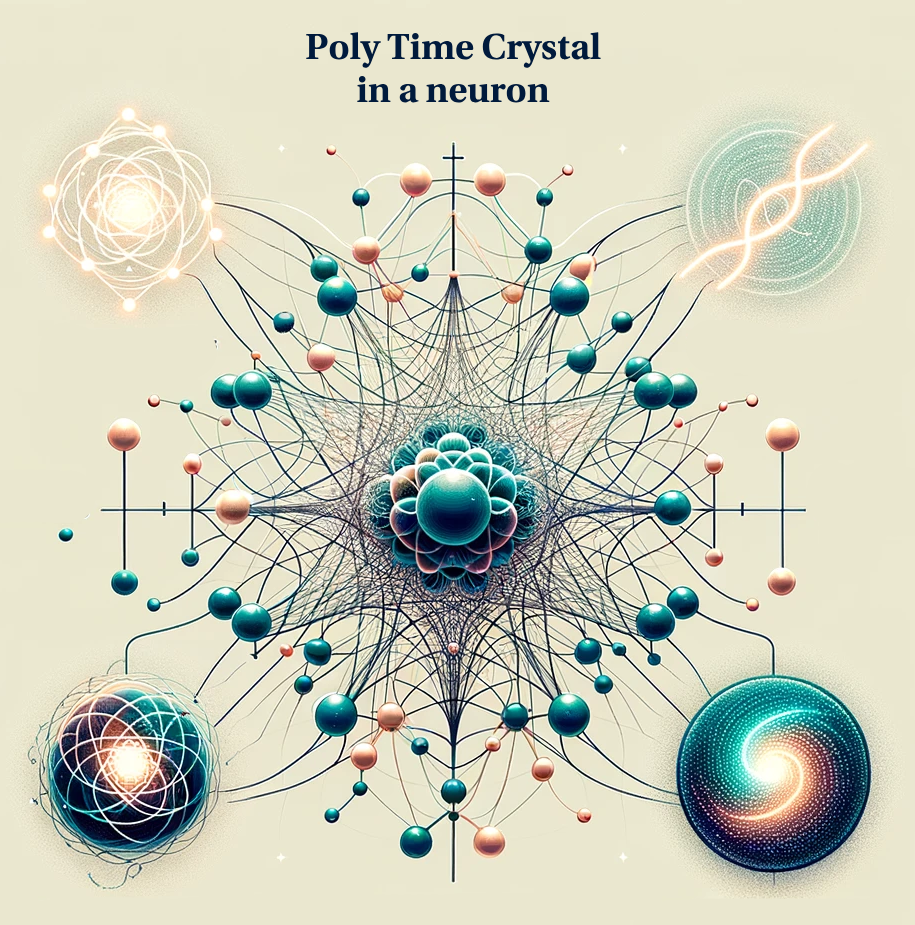
Abstract
This article challenges the traditional understanding of time crystals and introduces a new paradigm based on polyatomic time crystals derived from proteins, microtubules, and neuronal structures. We argue that the existing concept, rooted in the assumption that time symmetry breaking corresponds with simple harmonic generation, is fundamentally flawed. Our findings suggest a complex interaction within biomolecular structures that breaks time symmetry in a novel manner, thus reshaping the potential applications in materials science and computing.
Introduction
The theory of time crystals has historically conceptualized that a shift to different harmonic frequencies indicates a breaking of time symmetry (Strocchi, 2005). This research critiques this view by demonstrating that such shifts in biomaterials like proteins and microtubules do not represent genuine time symmetry breaking.
New Paradigm of Time Crystals
Research utilized advanced quantum optics to examine the time crystal behavior in proteins and microtubules within neurons. Biohological structures do not follow predicted harmonic patterns but instead exhibit time crystal characteristics at frequencies significantly lower than expected, suggesting a genuine break in time symmetry (Saxena et al., 2022).
Methodology
We employed a combination of dielectric resonance and quantum optics experiments to investigate the microtubule structures extracted from neurons. This approach revealed the existence of polyatomic time crystals that operate independently of the classical harmonic expectations.
Results
The experiments demonstrated that new clocks within the polyatomic time crystals function at frequencies a thousand times lower than the original clocks, contradicting the traditional harmonic model. This finding not only refutes the current theoretical framework but also indicates a more complex underlying temporal structure.
Discussion
The implications of these findings extend beyond theoretical physics, suggesting potential applications in developing new materials and technologies that leverage the unique properties of time crystals in biological and synthetic systems.
Conclusion
This study fundamentally challenges and reshapes the understanding of time crystals, suggesting that the current theoretical framework is inadequate. We propose a new model that accurately reflects the complex nature of time symmetry breaking in biological systems.
References
Saxena, K., Singh, P., Sarkar, J., Sahoo, P., Ghosh, S., Krishnanda, S. D., … & Bandyopadhyay, A. (2022). All Basics that Are Wrong with the Current Concept of Time Crystal: Learning from the Polyatomic Time Crystals of Protein, microtubule, and Neuron. In Proceedings of Trends in Electronics and Health Informatics (pp. 243-252). Springer, Singapore. https://doi.org/10.1007/978-981-16-8826-3_22
Reimagining Brain Functionality: Insights from a Self-Operating Time Crystal Model
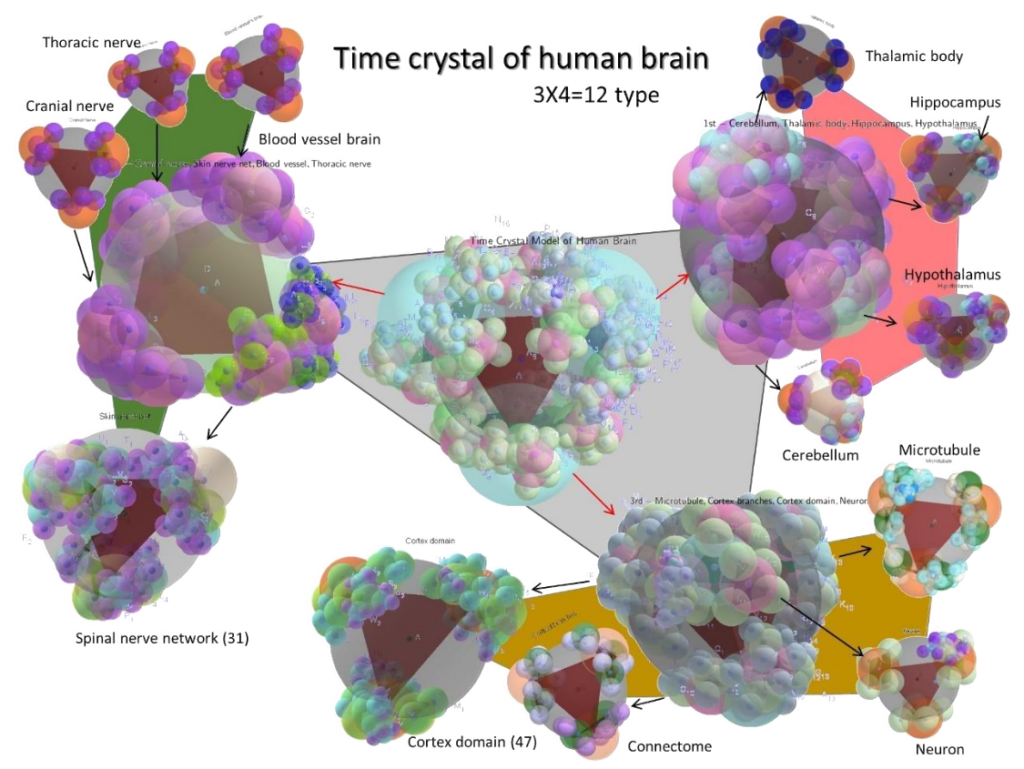
3D Poly Time Crystal 12 componen model for the complete human brain
Introduction
Recent advancements in theoretical physics and neurobiology have led to the development of a novel concept in brain modeling— the Time Crystal Model of the Human Brain. This concept is based on the integration of self-operating time crystals, proposing a transformative approach to understanding brain architecture and functionality. Time crystals, a phase of matter that exhibits perpetual motion without energy input, provide a fresh perspective on neural processing, potentially redefining conventional views on cognition and consciousness.
The Concept of Time Crystals in the Brain
Time crystals were initially conceptualized to explain autonomous biological rhythms such as heartbeat and neuron activity. The brain, an orchestrator of biological rhythms, can be viewed as a complex system of integrated time crystals, each representing a neural component with its own periodic function. The key insight of the time crystal model is the perpetual, self-regulated oscillation of these components, which mimics the autonomous nature of brain activities.
Poly-Time Crystals and Brain Function
Expanding on the basic time crystal model, researchers have proposed a more complex structure termed ‘poly-time crystals.’ These are not confined to single periodic activities but involve a 3D architecture where multiple time crystals interact and reset in response to physiological perturbations. This model mirrors the dynamic and adaptive nature of brain functions, where different neural pathways activate and synchronize to process information and maintain homeostasis.
Theoretical and Practical Implications
The implications of applying time crystal theory to brain function are profound. Theoretically, it suggests that the brain operates like a clockwork, composed of myriad clocks that reset and synchronize, thus maintaining its operational continuity through dynamic changes. Practically, this model could lead to breakthroughs in artificial intelligence and neurocomputing, where brain-like processing systems could be developed based on the principles of time crystal dynamics.
Towards a Global Mapping Effort
The authors advocate for a global effort to map the ‘brain clocks,’ analogous to the connectome project that maps neural connections. This mapping would aim to identify and describe the myriad time-crystalline processes within the brain, providing a temporal blueprint of brain activity. Such comprehensive mapping could revolutionize our understanding of brain dynamics and pave the way for innovative treatments for neurological disorders.
Conclusion
The Self-Operating Time Crystal Model offers a radical yet promising perspective on brain function, suggesting that the brain’s complex processes might be orchestrated by a lattice of time crystals. While still theoretical, this model opens new avenues for research into the fundamental workings of the brain, with potential applications ranging from neuroscience to the development of sophisticated neural networks.
This article presents a synthesis of innovative research on the application of time crystal theory to brain function, proposing a paradigm shift in how we understand and model the brain’s intricate workings. Such pioneering work promises not only to enhance our comprehension of biological rhythms and cognitive processes but also to inspire future technological advances in biocompatible computing systems.
Reference
Singh, P., Saxena, K., Singhania, A., Sahoo, P., Ghosh, S., Chhajed, R., Ray, K., Fujita, D., & Bandyopadhyay, A. (2020). A Self-Operating Time Crystal Model of the Human Brain: Can We Replace Entire Brain Hardware with a 3D Fractal Architecture of Clocks Alone? Information, 11(5), 238. https://doi.org/10.3390/info11050238
